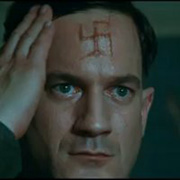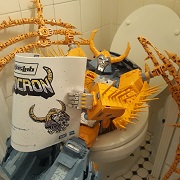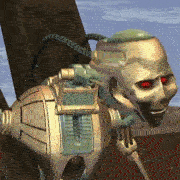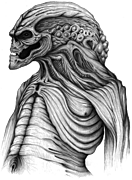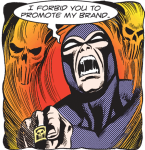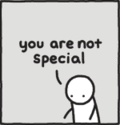|
I pity anyone who missed out on DOTM Hatchet.
|
|
|
|

|
| # ? May 14, 2024 00:32 |
|
Why cookie Rocket posted:I am assuming I have posted at least twice with the full pitch version of this post but the short version is that I want a historical line of TFs so badly. Greek trireme, siege engine, Roman chariot, Chinese palanquin, Egyptian barge....I would buy them all. That would be really cool. I would buy those toys as well. I liked the concept of the Seekers (old-timey vehicles) from Revenge of the Fallen, though I only got Hubcap from that line IIRC. My mind went to a Hearts of Steel-type background story (Hearts of Bronze? Hearts of Wood?) similar to that one G.I. Joe/Transformers drawn by Jae Lee, I always liked that one better than Hearts of Steel anyway. Yeah, I'm a huge nerd, posting in a thread about transforming toys. What. Why cookie Rocket posted:Also am I the only person that likes the Quints around here? They have always appealed to me.) GUILTY Comfortador posted:AOE/Future speculation They have many faces for him to take It's all been building up to that one wonderful moment...
|
|
|
|
I just picture Optimus like a kid in a candy store, giggling and skipping through the aisles of a Quint command ship, doing little twirls as he sings his happy give me your face song, Quints spinning like tops with faces flying everywhere. Maybe the movie could start with some Quintesson legend of one of their creations rising up to overthrow them, the dreaded legendary super facetaker. Bunch of cave paintings drawn by a Quintesson holding a paintbrush in his mouth.
|
|
|
|
The best Quintesson was the Quintesson from Energon, of course. hehehe "Alpha Q".
|
|
|
|
I just saw AOE and I loving loved it. It was balls-to-the-walls bananas the whole way through. Of note (I don't think these are significant spoilers but whatever): - The American flag standing in on EVERY kind of action. Someone does something evil--FLAG. Someone does something good--FLAG. Someone stands up for something they believe in--FLAG. Someone breaks apart something completely incidental--FLAG - I can't decide if Stanley Tucci's character is a third-party developer or fanboys. I think the latter (I would like this, as it makes Bay a little less cynical). "WHY CAN'T IT BE THE WAY I WANT IT? WHY? WHY?" "Do you know what a flaw is? A flaw is a FAILURE." - The autobots are so sociopathic omg. "We must proceed without violence." STAB STAB STAB. - Frasier is Optimus Prime and it is hilarious. I love how much his rhetoric mirrors Prime's, except for when he's demanding that he get paid. This makes me wonder even more about Prime's motivations, and if he's going to be mad at his creators for not getting some form of a cosmic paycheck. - Lockdown is amazing, as everybody said. - Wahlberg becomes Optimus Prime as well (super obvious "fist down to the ground" transformation after his daughter is taken. Everyone is Optimus. Everyone is terrible. It's delightful. - how stupidly wonderful is it that the one black character in the movie interacting with the hard-at-work and (working stupidly) inventor is literally a sassy fat "taker" - Optimus said he swore he'd never hurt a human. That...never happened, right? At least not on screen?
|
|
|
|
Captain Magic posted:
Not on purpose. Except for that one time.
|
|
|
|
CAPT. Rainbowbeard posted:Not on purpose. Except for that one time. He blows at least one person away casually. not to sure about the opening fight he is in. Doesn't he pretty much declare that he will not murder humans, apart from frasier? Full on expecting some fuckery with the extracted sparks, we've at least seen Ratchets get yanked so it's safe to assume that this is Lockdowns usual way of operating in taking down a former. maybe cyclonus and co show up? Wonder what they'd turn the autobots into.
|
|
|
|
AzMiLion posted:He blows at least one person away casually. not to sure about the opening fight he is in. Doesn't he pretty much declare that he will not murder humans, apart from frasier? You see one Graveyard Wind guy get blown off his feet by one of Optimus' shots as he dives out of the barn, but given the punishment Wahlberg & Co. can take over the course of the film and not even break stride, he was probably fine. Clearly humans in the Bayverse are far more durable than we are.
|
|
|
|
Thanks to whoever posted that Scoria fix a few pages back. The creator responded on TFW that people who have an issue with the shoulder should contact the retailer they bought it from as he will be providing them with replacement parts, so I'll prob give that a go before trying the Future fix. Why cookie Rocket posted:I was asking about this a few weeks back-- how is the plastic quality on that Grimlock? Some target exclusives have had horrible plastic quality. Feels the same, though one of the t-rex arms pops off on mine with the slightest touch. And for all the chrome in this set it would have been nice if they chromed the t-rex arms :-/ It's on sale at Target for $25 and you get a $5 gift card. The Prime it comes with isn't bad either. catch22 fucked around with this message at 06:05 on Jul 4, 2014 |
|
|
|
Oh, I didn't mean that Prime didn't kill humans (he clearly seems to have very little trouble with that), but him saying that he promised it at all was a shock to me. Did that promise happen on screen in previous films?
|
|
|
|
Captain Magic posted:- The autobots are so sociopathic omg. "We must proceed without violence." STAB STAB STAB. The factions seem to be pretty meaningless in this film, even Lockdown is unimpressed with divisions between them. Given the attitude of all the 'Autobots', I wouldn't have been surprised if Prime just went out conscripting Decepticons into their ranks with a "Join me or die!" ultimatum.
|
|
|
|
JediTalentAgent posted:The factions seem to be pretty meaningless in this film, even Lockdown is unimpressed with divisions between them. Given the attitude of all the 'Autobots', I wouldn't have been surprised if Prime just went out conscripting Decepticons into their ranks with a "Join me or die!" ultimatum. Why settle for Decepticons when he could do it with Dinobots? And wasn't THAT scene weird? Was I the only one who got the impression the Dinobots were some kind of supreme war criminals, and that it was sort of a massive deal for Prime to call on them for help at all? I am usually fine with implications, but I would have liked some more overtness about their and Prime's relationship. But, at the same time, as it stands he's beating freedom into them, so yayyyy
|
|
|
|
Captain Magic posted:Was I the only one who got the impression the Dinobots were some kind of supreme war criminals, and that it was sort of a massive deal for Prime to call on them for help at all? But yes, that scene was loving bizarre. The decision to not have them talk made absolutely no sense - a tiny amount of dialogue from them and the whole last act of the movie is much better.
|
|
|
|
I wrote an article about the original 80s film, for some reason. I just centrally love that the Matrix of Leadership represents the childish power to simplify everything into an understandable conflict - its presence turns Unicron from a horrifying planet that eats planets into a dude with a horned helmet, a mustache to twirl, and silly devil wings. It literally turns nihilism into a cartoon character.
|
|
|
|
DoctorWhat posted:I have never bought a Cyberverse and I never will. I will be strong. If you bought a Legends figure you bought a Cyberverse.
|
|
|
|
Spiderdrake posted:Uhh, yeah, you completely spun that out of thin air. They're Knights of Cybertron who were looking for their creators, who Optimus traveled with for a time, and Lockdown stole their ship (or maybe was one of them, I think he called Lockdown a traitor of some kind) before incarcerating them. Optimus even calls them legendary knights and he greets Grimlock with "the legends are true". Up until now, every alien character has learned English by scanning the Internet. The dinobots did not have that opportunity, since they only visited Earth in medieval times. With no cars or Internet to scan, they became dragons and knights - because that's what people worshipped instead. Naturally, they communicate mostly with symbolic violence - Optimus punching out their leader and drawing a blade along his neck. "The legends are true" is a very ambiguous line. Since Optimus has met these guys before, it's not like he's totally surprised to see them. He's asserting that he himself is a true legend. Optimus then unleashes these dragons upon the Earth. Going back to Beast Wars: what is Megatron if not an identical robot in dinosaur clothing - though one who does not submit?
|
|
|
|
I was under the impression that the Dinobots were a little crazy from being held upside down for at least several thousand years and a show of force was the only thing they could understand, or some other crazy modern interpretation of "the Dinobots are all violent morons" in the same vein as Prime and Bumblebee's moderns interpretations. The Dinobots are finally free; the last thing they need is another tiny rear end in a top hat with power over them. Maybe if Bender had got off his shiny metal rear end and took
|
|
|
|
Spiderdrake posted:Uhh, yeah, you completely spun that out of thin air. They're Knights of Cybertron who were looking for their creators, who Optimus traveled with for a time, and Lockdown stole their ship (or maybe was one of them, I think he called Lockdown a traitor of some kind) before incarcerating them. Optimus even calls them legendary knights and he greets Grimlock with "the legends are true". I would concur that Prime is referring to himself as a legend. I guess my chain of logic was that from what we have seen, the guys Lockdown goes after do not seem to be nice. At the risk of putting myself liable to a guilty by association fallacy, if someone wants to lock up Prime then I'm going to assume others locked up by the same person are as bad or worse. And, that they were the Knights doesn't exclude them from any horrific acts. I was curious why Prime didn't let them out immediately if he had traveled with them before; when he's busy beating liberty into them while shouting at them in a language they almost certainly don't understand, he seems almost confused to me (though Prime is always confused about people not doing what he says). Grimlock reacted violently to Prime, but if he was expecting that, isn't that saying something all by itself? The Autobots are clear sociopaths, and Prime calms them earlier with just a warning when they are on the brink of violence. I wonder if the level of violence needed to discipline something in Prime's eyes is a gauge for how "moral" these beings are. But yeah they might not be war criminals. Something weird is happening with them, though. It's interesting to consider. I keep thinking about slave ships and the crews who were imprisoned by revolting slaves (they're locked up on their own ship, after all), but I don't think I can make that work. Edit: Also, the film states explicitly that the Knights were looking for Creators? I missed that. Prime seems surprised by Lockdown's affirmation of creators at all. If the above is true, are we to understand that Prime lost some of his memory? He explicitly bangs his damaged chest/spark when referring to his memory. Captain Magic fucked around with this message at 17:10 on Jul 4, 2014 |
|
|
|
CAPT. Rainbowbeard posted:I was under the impression that the Dinobots were a little crazy from being held upside down for at least several thousand years and a show of force was the only thing they could understand, or some other crazy modern interpretation of "the Dinobots are all violent morons" in the same vein as Prime and Bumblebee's moderns interpretations. But then they do follow him, even letting him ride them. They clearly have some kind of code of honor that Optimus knew he could exploit. I mean, they will seemingly obey anyone who defeats their leader in combat. Notably, all the other Autobots are like 'gently caress this poo poo'. All this stuff about legends and honor is totally personal for Optimus.
|
|
|
|
I just wanna say that the movie has a dedicated thread in CineD, so discussion of it really should go there. On an unrelated note: I do find it funny just how many loving versions of Evasion Prime there are already. It's like a seeker or something, only its all a single character somehow. I guess at least that increases my chances of getting my hands on one eventually.
|
|
|
|
It is a really good mold though and people like it, so I guess run that poo poo into the ground while you can.
|
|
|
|
Yeah it's insane how many versions are announced already. The master mold is gonna crumble to dust in like a year.
|
|
|
|
With what, eight new AOE deluxe and four voyager molds - I'm surprised there aren't a half dozen Bumblebee repaints.
|
|
|
|
strangehamster posted:With what, eight new AOE deluxe and four voyager molds - I'm surprised there aren't a half dozen Bumblebee repaints. Once the new Bumblebee mold gets into the wild, we will unable to escape it.
|
|
|
|
DoctorWhat posted:Once the new Bumblebee mold gets into the wild, we will unable to escape it. Where's my Stinger deluxe?!?!? Was it a cancelled Wal*Mart exclusive after all?
|
|
|
|
strangehamster posted:Where's my Stinger deluxe?!?!? Was it a cancelled Wal*Mart exclusive after all? Not canceled apparently, but it is a Walmart exclusive. That's a pain, since there aren't any Walmarts less than 20 or so miles from here, but I like the Stinger design. Road trip it is, then.
|
|
|
|
Blackheart posted:Yeah it's insane how many versions are announced already. The master mold is gonna crumble to dust in like a year. How does that work, anyway? They really only make one mold from which to create all the other toys? There's no way to like, update over time?
|
|
|
|
So there's a quasi G1 Tankor I did not know this, also the Dorvack version of Whirl was a girl.
|
|
|
Captain Magic posted:How does that work, anyway? They really only make one mold from which to create all the other toys? There's no way to like, update over time? Industrial molds are steel tooling in the area of $200k a pop. It's a fairly compelling reason for a toy company to get as much mileage out of the mold as possible through repaints and redecos and whatnot. You can modify a mold (the one that pops immediately to mind for some reason is when they removed the molded Autobot insignia from Cybertron Overhaul to make Brushguard) but the change generally tends to be permanent (Movie Warpath using the same mold no longer has the molded insignia despite being an Autobot). The Taint Reaper posted:I did not know this, also the Dorvack version of Whirl was a girl. Piloted by a girl. All the Dorvack robots were piloted mechs, like in Macross.
|
|
|
|
|
Here's a video of Sky-Byte. https://www.youtube.com/watch?v=FXn3Kjp4Ks4
|
|
|
|
I wonder if there's some way of positioning the back wings over his shoulders as armor.
|
|
|
|
Holy crap, $200k? How does that all get split up between design, labor, and parts? It's nuts to me thinking that a third-party developer would invest even a quarter of that amount. Do they need less costly molds because their production runs are so much smaller?
|
|
|
|
Dear Hasbro, We do not see eye-to-eye on this AoE stuff. See you when you get Generations stuff in to stores in Kansas. Sincerely: Anora P.S. Scorn was better then Slug. P.S.S. Dammit
|
|
|
|
Terry van Feleday posted:On an unrelated note: I do find it funny just how many loving versions of Evasion Prime there are already. It's like a seeker or something, only its all a single character somehow. Does anyone know when/where a faceplated version of the mold supposed to hit US retail? I remember seeing pics/reviews of a Grimlock/faceplate Evasion Prime 2-pack but I've never seen a spot for it on shelves anywhere.
|
|
|
|
 Who is this? I can't find company stamp but I'm guessing it's a Bandai fig e: thanks! catch22 fucked around with this message at 18:18 on Jul 5, 2014 |
|
|
|
catch22 posted:
It's the Blue Ranger's second Zord from Power Rangers Turbo (or Carranger, maybe). DoctorWhat fucked around with this message at 18:20 on Jul 5, 2014 |
|
|
|
catch22 posted:
That's V-Police, from the second set of Carranger Mecha/Power Rangers Turbozords.
|
|
|
|
The MSJ posted:Here's a video of Sky-Byte. [L]et us begin by taking up undoubtedly Zizek's best known example of the master-signifier in action: the figure of the shark from Jaws. Of course, like all great movie monsters, the shark can be seen as representative of many things, from the forces of nature fighting back (as humans increasingly encroach on its territory), to the eruption of sexuality (it appears after two teenagers attempt to have sex in the water), from the threat of the Third World to America (the shark, like illegal immigrants, arrives by the sea) to the excesses of capitalism (as revenge for the greed of the town mayor and resort owners in refusing to close the beach during a holiday weekend). In this sense, the shark can be understood as allowing the expression of ordinarily repressed desires and impulses within society, making explicit its usually unspoken ideologies and beliefs. And it is into this interpretive milieu that the analyst enters when they argue that it is their conception of the shark that best offers an insight into the society that produced it. However, as we have already seen with the 'rise' of the Nazi narrative in Germany in the 1930s, it is exactly here not a matter of deciding which account of the shark best corresponds to the truth of contemporary society, for it is the shark itself that each time constructs society in its image. Or, to put it another way, the analyst already has something to say about society (some point to make about the environment, sexuality or capitalism), which they then attribute to the shark. In both cases, what is not questioned - what the overwhelming physical presence of the shark allows us to forget - is that this is only an interpretation of society. What is not seen is that circularity according to which the shark is seen as embodying certain tendencies that have already been attributed to the shark. As Zizek says of what he calls this 'direct content analysis': '(It) proceeds too quickly and presupposes as self-evident the fantasy surface itself, the empty form/frame which offers space for the appearance of the monstrous content'. That is, the true ideological effect of the shark, how it functions as a master-signifier, is to be found not in the way it represents certain tendencies in society that are already recognized but in the way it allows us to perceive and state these tendencies for the first time. It is the shark itself that allows the various fantasies and desires of the analyst - the true 'monstrous content' Zizek speaks of - to be expressed as though with some evidence, as though speaking of something that is actually there. As we saw with the re-mark, if the shark appears merely the expression of social forces that already exist, these forces would also not exist without the shark. If the shark appears simply to put a name to things, these things could also not be perceived before being named. (Zizek says the same thing about Hitchcock's The Birds: that if the film dramatizes certain pre-existing family tensions, these tensions could not be seen without the birds. But, again - this is the very 'fantasy frame' that allows these 'monstrous contents' to be registered - in this circularity something new is brought about. If the shark expresses only what is already attributed to it by various interpreters, it also appears to be what they are all talking about, what they all have in common, even in their very differences from and disagreements with each other. It is over the meaning of the shark that they dispute, as though it is real, as though it is more than others see in it. And it is in this way, finally, that the shark acts as a master-signifier, as what various ideological tendencies recognize themselves in, what 'quilts' them, makes them equivalent. As the critic Fredric Jameson writes, in a passage cited by Zizek: "The vocation of the symbol - the killer shark - lies less in any single message or meaning than in its very capacity to absorb and organize all of these quite distinct anxieties together. As a symbolic vehicle, then, the shark must be understood more in terms of its essentially polysemous function rather than as any particular content attributable to it by this or that spectator." However, to try to draw out what Jameson is saying a little more, what is implied here is that there is some 'real' shark behind all of the various interpretations of it. It would be a shark that is not only what is in common to all of these interpretations but what all of them try (and fail) to take account of. It would be a shark that is more than any of these interpretations and that is unable to be captured by any one of them - something that in a sense cannot be named, and for which the shark itself is only a substitute. It is what Zizek calls in similar circumstances what is 'in shark more than shark', the shark as object a. And it is what we have already seen make it so hard to think outside of the master-signifier, because this outside is what the master-signifier is. From now on, the very differences or even incommensurabilities in interpretation (of society) are only able to take place as though they are arguing over the 'same' shark. But let us try to analyse how this object a works to allow the master-signifier, and how, if it closes off any simple outside, it might also open up a certain 'alternative' to it. As we say, the shark is merely a tissue of differences. In a circular way, it is not what various interpretations seek to describe but what is retrospectively seen to fill out various interpretations. To this extent, there is a kind of infinite regress implied in trying to speak the truth of the various interpretations of the shark, insofar as they correspond to the social, because this social can only be seen through the shark. As with the system of language, the shark and these various interpretations of the social are mutually defining. And yet, as with the system of language, we must also try to find what all of these elements attempt to stand in for, what initiates this process of definition. And this is what Zizek calls the shark as object a: what holds the place of that 'pure difference' that both the shark and its interpretations seek to exchange themselves for. We might put this another way - and begin to think what Zizek means when he says that ideology today already incorporates its own distance from itself. We have spoken of how the shark is never a neutral or natural object but always from the beginning only a reflection or expression of competing ideologies. And it is into this contested field that the analyst necessarily enters. That is, even the first description of the shark is already an attempt to speak of, displace, other interpretations. Each description is not merely a description but as it were a meta-description, an attempt to provide that point de capiton that quilts all the others. Thus, when it speaks of the shark, it also wants to speak of what all those others that speak of it have in common, what they all stand in for. And it is in this sense - it is just this that we see in cultural studies-style analyses of such objects as Jaws - that each attempt not only is ideological but also attempts to break with ideology, to take a certain distance from those other accounts which it perceives as ideological, to speak of what they leave out. But it is precisely in this way that the shark once again weaves its magic, for we are only able to criticize others for being ideological by assuming that there is some real shark that others - and perhaps, in a final 'postmodern' twist, even we - get wrong. That is, in order to criticize others for being ideological, for seeing the shark only as a reflection of their own interests, we have to assume a 'true' shark that they do not speak of, which can only be a reflection of us. As Zizek writes: 'This tension introduces a kind of reflective distance into the very heart of ideology: ideology is always, by definition, 'ideology of ideology'... There is no ideology that does not assert itself by means of delimiting itself from another mere 'ideology'. To be more exact, what each master-signifier attempts to speak of is that difference - that gap or void in the signifying order - that allows others (and even itself) to speak of it. In a paradoxical way, at once each master-signifier begins by attempting to displace the others, to speak of that difference excluded to allow any of them to speak of the others, and this difference would not exist until after it. This, again, is Zizek's insight that the shark as master-signifier does not precede the various attempts to speak of it, but is only the after-effect of the failure to do so, is nothing but the series of these failures. However, it is just this that provokes a kind of infinite regress, with a certain lack - object a - always to be made up, as each successive master-signifier attempts to speak of what precedes and allows the one before. And in this context the anti-ideological gesture par excellence is not at all to speak of what is left out of each master-signifier, of how it 'distorts' reality, but to show how it structurally takes the place of a certain void, is merely 'difference perceived as identity'. But, again, this is very complex - and we return to those questions we raised in our Introduction - in that this attempt to speak of that void that precedes and makes possible the master-signifier can only be another master-signifier. In that ambiguity that runs throughout this book, that object a we speak of that allows this differential structure of the master-signifier, as what all of these differences have in common, at once is the only way we have of exposing the master-signifier and is only another master-signifier, reveals the emptiness that precedes the master-signifier and can do this only by filling it up again. All of this points towards the very real difficulties involved in the analysis of ideology - not only, as Zizek often indicates, in so-called 'discourse analysis', whose presumption of a non-ideological space can always be shown to be ideological, but even in Zizek's own project of uncovering the 'sublime object' or object a of ideology. But in order to consider this in more detail, let us turn to perhaps the privileged example of the master-signifier (and of object a) in Zizek's work: the anti-Semitic figure of the 'Jew'. We have already, of course, looked at the notion of the 'Jewish plot' with regard to the Dreyfus case. It is the idea that, behind the seemingly innocent surface of things, events are secretly being manipulated by a conspiracy of Jews. More specifically, as we see for instance in Nazism, it is the idea that the series of different reasons for Germany's decline in the 1930s, reasons that would require detailed social and historical - that is, political - analysis, are ultimately to be explained by the presence of Jews. And yet, as with the shark in Jaws, it is not as though these 'Jews' embody any actual qualities, correspond to any empirical reality; or they are only to be defined by their very 'polysemousness', their contradictoriness - as Zizek says, Jews are understood to be both upper and lower class, intellectual and dirty, impotent and highly sexed. This is why the anti-Semite is not to be discouraged by the lack of empirical evidence, the appeal to facts, the way that Jews are not really as they describe them. The notion of the 'Jewish plot', like all of our master-signifiers, functions not directly but only indirectly, incorporates our very disbelief or scepticism into it. It is for this reason, as Zizek writes, that even when confronted with evidence of the 'ordinariness' of his archetypal Jewish neighbour, Mr Stern, the anti-Semite does not renounce their prejudices but, on the contrary, only finds in this further confirmation of them: "You see how dangerous they really are? It is difficult to recognize their true nature. They hide it behind the mask of everyday appearance - and it is exactly this hiding of one's real nature, this duplicity, that is a basic feature of the Jewish nature." And this is why, behind the obvious conspiracy - that of the master-signifier - there needs to be another, of which the master-signifier itself is part. As Zizek writes in the essay "Between Symbolic Fiction and Fantasmatic Spectre: Towards a Lacanian Theory of Ideology": "This other, hidden law acts the part of the 'Other of the Other' in the Lacanian sense, the part of the meta-guarantee of the consistency of the big Other (the symbolic order that regulates social life). The 'conspiracy theory' provides a guarantee that the field of the big Other is not an inconsistent bricolage: its basic premise is that, behind the public Master (who, of course, is an imposter), there is a hidden Master, who effectively keeps everything under control." But what exactly is wrong with the empirical refutation of anti-Semitism? Why do we have the feeling that it does not effectively oppose its logic, and in a way even repeats it (just as earlier we saw the cultural studies-style rejection of competing interpretations of the shark - 'It is not really like that!' - far from breaking our fascination with the shark, in fact continuing or even constituting it)? Why are we always too late with regard to the master-signifier, only able to play its interpretation against the object or the object against its interpretation, when it is the very circularity between them that we should be trying to grasp? Undoubtedly, Zizek's most detailed attempt to describe how the master-signifier works with regard to the Jew is the chapter "Does the Subject Have a Cause?" in Metastases of Enjoyment. As he outlines it there, in a first moment in the construction of anti-Semitic ideology, a series of markers that apparently speak of certain 'real' qualities is seen to designate the Jew, or the Jew appears as a signifier summarizing - Zizek's term is 'immediating, abbreviating' - a cluster of supposedly effective properties. Thus: (1) (avaricious, profiteering, plotting, dirty . . .) is called Jewish. Then, in a second moment, we reverse this process and 'explicate' the Jew with the same series of qualities. Thus: (2) X is called Jewish because they are (avaricious, profiteering, plotting, dirty . . .). Finally, we reverse the order again and posit the Jew as what Zizek calls the 'reflexive abbreviation' of the entire series. Thus: (3) X is (avaricious, profiteering, plotting, dirty . . .) because they are Jewish. In this third and final stage, as Zizek says, Jew 'explicates' the very preceding series it 'immediates' or 'abbreviates'. In it, 'abbreviation and explication dialectically coincide'. That is, within the discursive space of anti-Semitism, Jews are not simply Jews because they display that set of qualities (profiteering, plotting . . .) previously attributed to them. Rather, they have this set of qualities because they are Jewish. What is the difference? As Zizek emphasizes, even though stage (3) appears tautological, or seems merely to confirm the circularity between (1) and (2), this is not true at all. For what is produced by this circularity is a certain supplement 'X', what is 'in Jew more than Jew': Jew not just as master-signifier but as object a. As Zizek says, with stage (3) we are not just thrown back on to our original starting point, for now Jew is 'no longer a simple abbreviation that designates a series of markers but the name of the hidden ground of this series of markers that act as so many expression-effects of this ground'. Jew is not merely a series of qualities, but what these qualities stand in for. Jew is no longer a series of differences, but different even from itself. But, again, what exactly is meant by this? How is the Jew able to move from a series of specific qualities, no matter how diverse or even contradictory, to a master-signifier covering the entire ideological field without exception? How is it that we are able to pass, to use an analogy with Marx's analysis of the commodity form that Zizek often plays on, from an expanded to a 'general' or even 'universal' form of anti-Semitism? The first thing to note here is that stages (1) and (2) are not simply symmetrical opposites. In (1), corresponding perhaps to that first moment of ideological critique we looked at with Jaws, a number of qualities are attributed to the Jew in an apparently immediate, unreflexive way: (profiteering, plotting . . .) is Jew. In (2), corresponding to that second moment of ideological critique, these same qualities are then attributed to the Jew in a mediated, reflexive fashion: Jew is (profiteering, plotting . . .). In other words, as with the shark in Jaws, we do not so much speak directly about the Jew, but about others' attempts to speak of the Jew. Each description before all else seeks to dispute, displace, contest others' attempts to speak of the Jew. Each description is revealed as a meta-description, an attempt to say what the Jew and all those others have in common. Each description in (1) is revealed to be an implicit explication in (2). Each attempts to name that difference - that 'Jew' - that is left out by others' attempts to speak of the Jew. Each attempts to be the master-signifier of the others. And yet - this is how (3) 'returns' us to (1); this is how the Jew is not just a master-signifier but also an object a - to the very extent that the Jew is only the relationship between discourses, what allows us to speak of others' relationship to the Jew, there is always necessarily another that comes after us that speaks of our relationship to the Jew. Jew in this sense is that 'difference' behind any attempt to speak of difference, that 'conspiracy' behind any named conspiracy. That is, each description of the Jew can be understood as the very failure to adopt a meta-position vis-�-vis the Jew. Each attempt to take up a meta-position in (2) is revealed to be merely another in an endless series of qualities in (1). That master-signifier in (2) that tries to name what all these different descriptions have in common fails precisely because we can always name another; the series is always open to that difference that allows it to be named. And 'Jew', we might say, is the name for this very difference itself: object a. We might put this another way in thinking how we finally get to the master-signifier in its 'universal' form, the master-signifier as where 'abbreviation and explication dialectically coincide'. As we have already said, each description of the master-signifier is before all else an attempt to stand in for the other, to take the place of that void which the Jew and its previous descriptions have in common. And yet each description necessarily fails. For any attempt to say what a Jew is we can always find an exception; we can always be accused once again of leaving out the Jew. Indeed, in a certain way, our own list is made up of nothing but exceptions, attempts to say what those previous descriptions left out. We ultimately have only an endless series of predicates with nothing in common or, as Zizek says, a "never-ending series of 'equivalences', of signifiers which represent for it [the master-signifier] the void of its inscription'. Nevertheless, as we say, each new predicate, if it attempts to stand in for this void, also opens it up again. It too will require another to say what it and all those others have in common. As before, we can never finally say what all those descriptions share, what is behind them all. There is no way of saying what a Jew is or even how this sequence began in the first place. The only way out of this impasse - this, again, is how the master-signifier comes to be supplemented by object a - is to reverse this, so that the Jew just is this difference, the void of its inscription, what allows us to speak of the failure to symbolize the Jew. As Zizek says, the only way out is to 'reverse the series of equivalences and ascribe to one signifier the function of representing the object (the place of inscription) for all the others (which thereby become 'all' - that is, are totalized). In this way, the proper master-signifier is produced." However, to put all of this in a more Hegelian perspective - in which scission is already reconciliation - it is not as though this reversal actually has to take place. Rather, our very ability to mark these attempted descriptions as failures, as exceptions, that is, our very ability to re-mark them at all (close to the idea that there is not a 'crisis' until the narrative of Nazism or that those various ideological forces cannot be articulated until the arrival of the shark), already indicates that they stand in for an absent signifier. We cannot even have this endless series of predicates unless they are all speaking about the 'same' Jew. If we can never say what the Jew is, then, this is only because, as Zizek says of the letter - and the Jew is only a letter or a signifier - we have already found it. The Jew is nothing else but this endless series of predicates, this perpetual difference from itself. Crucially, however, if the Jew cannot be made into a 'figure' (named as such), neither can it be designated a 'ground' (that for which things stand in). For, in that way we have just seen, any attempt to say what a Jew is, even as a series of qualities, is only to open up an exception, raise the necessity for another ground against which this can be seen. Rather, the 'Jew' as object a, the 'sublime object' of ideology, is what allows (and disallows) the relationship between ground and figure, is that void for which both stand in. If in one way, that is, the Jew can only be seen as either (1) or (2), figure or ground, in another way, as we have seen with the shark, it is the very circularity between them. And in speaking of the Jew as the 'dialectical coincidence' of 'abbreviation' (figure) and 'explication' (ground), Zizek does not mean that they become the same or are ever finally reconciled, but that each exchanges itself for the other, holds the place of the other. The description of the empirical Jew in (1) is only possible because of the underlying Jew of (2). And every attempt to say what the Jew as master-signifier is in (2) fails, reveals itself only to be the Jew of (1). (1) is only possible because of (2) and (2) can only be seen as (1), but this only because of the Jew of (3), the Jew not only as the various signifiers of (2), what they all have in common, but the very difference between them, what they all stand in for. It is Jew as the name for this difference, as what is always different from itself. It is Jew not only as present in its absence but absent in its presence, as what everything, including any named Jew, tries and fails to represent: the Jew as truly 'universal'. - Rex Butler, "What Is A Master-Signifier" (link) (USER WAS PUT ON PROBATION FOR THIS POST)
|
|
|
|
catch22 posted:
Aww, he's so happy 
|
|
|
|

|
| # ? May 14, 2024 00:32 |
|
SuperMechagodzilla posted:- Rex Butler, "What Is A Master-Signifier" (link) Who's the baddest shark around? Who's the smartest shark in town? Sky-Byte, that's me! Who'll drive Scourge into the ground? And never let old Megatron down Sky-Byte, that's me! DoctorWhat fucked around with this message at 19:02 on Jul 5, 2014 |
|
|



